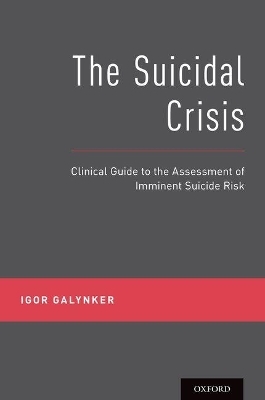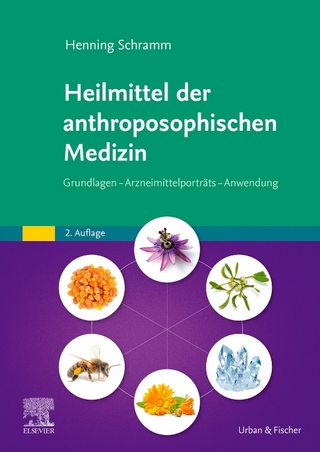
The Suicidal Crisis
Oxford University Press Inc (Verlag)
978-0-19-026085-9 (ISBN)
The Suicidal Crisis is an essential work for every mental health professional and for anyone who would like to have a framework for understanding suicide. Written by master clinician Dr. Igor Galynker, the book presents methods for a systematic and comprehensive assessment of short-term suicide risk and for conducting risk assessment interviews in different settings.
Dr. Galynker describes suicide as an attempt of a vulnerable individual to escape an unbearable life situation, which is perceived as both intolerable and inescapable. What sets the Suicidal Crisis apart from the other books of its kind is its sharp focus on those at the highest risk. It presents a wealth of clinical material within the easy-to-understand and intuitive framework of the Narrative-Crisis model of suicidal behavior. The book contains sixty individual case studies of actual suicidal individuals and their interviews, detailed instructions on how to conduct such interviews, and risk assessment test cases with answer keys. A unique feature of the book, not found in any other book on suicide, is a discussion of how clinicians' emotional responses to acutely suicidal individuals may help identify those at highest risk.
In this timely, thorough, and well-written monograph, Dr. Galynker provides a method for understanding the suicidal process and of identifying those at the highest risk for taking their lives. Any clinician who works with suicidal individuals-and anybody who knows someone who has considered suicide-will find the book an essential and illuminating read.
Dr. Igor I. Galynker is a clinical and research psychiatrist with broad interests in suicide prevention, bipolar disorder, behavioral addictions, and the role of family in psychiatric illness. He has published on these topics in professional journals and in the lay press and has authored a book on family involvement in psychiatric treatment. The Suicidal Crisis, Clinical Guide to the Assessment of Imminent Suicide Risk is the culmination of his work on pre-suicidal affective states and short-term suicide risk.
1. Introduction
a. Our inability to predict imminent suicide
b. Long-term and imminent suicide risk
c. Lack of instruments for suicide prediction
d. Clinical approach to imminent risk assessment
e. Multimodal assessments
f. One-informant vs. Multi-informant assessments
g. How to use the Clinical Guide A roadmap for comprehensive assessment
2. Chapter One: Psychological Models of Suicide
a. Introduction
b. Historical Perspective
c. Shneidman's Theory of Psychache
d. Suicide as Escape from Self
e. Suicide Crisis Syndrome (SCS) and the Positive Feedback Model of Suicide
f. The Cry of Pain/Arrested flight Models
g. Cognitive Vulnerability Model
h. Fluid Vulnerability Model
i. Beck's Diathesis-Stress Model
j. Mann's Stress-Diathesis Model
k. Joiner's Interpersonal Model
l. O'Connor's Integrative Motivational-Volitional Model
m. Summary
3. Chapter Two: The Narrative-Crisis Model of Suicide
a. Introduction
i. Trait vs. State risk factors
ii. Static vs. dynamic risk factors
b. The Narrative-Crisis Model Overview
c. The Trait Vulnerability Component
d. The Narrative Component
e. The Crisis Component
f. Model Flexibility
i. Narrative-Driven vs. Crisis-Driven Suicides
g. Conclusion
4. Chapter Three: Trait Vulnerability Assessment
a. Demographics
i. Age, Race, and Ethnicity
ii. Gender
iii. LGBT
b. History of Mental Illness and Suicide Attempts
i. History of Mental Illness
ii. History of Suicide Attempts
c. Childhood History
i. Childhood Trauma
ii. Parenting Style
iii. Attachment Style
d. Traits
i. Impulsivity
ii. Hopelessness and Pessimism
iii. Perfectionism
iv. Fearlessness and Pain Insensitivity
e. Cultural Acceptability
i. Cultural Attitudes and Immigration
ii. Immigration Status
iii. Moral, Philosophical, and Religious Objections
iv. Regional Affiliation
v. Suicide in the Family
vi. Suicide Clusters
vii. Suicide Exposure and Practicing
f. Case Examples
g. Test Cases
5. Chapter Four: Stressful Life Events
a. Introduction
b. Work and Career
i. Economic Hardship
ii. Business or Work Failure
iii. Loss of Home
c. Relationship Conflict
i. Romantic Rejection
ii. Intimate Relationship Conflict
iii. Parents in Conflict with Children
iv. Children in Conflict with Parents
v. Ongoing Childhood and Adolescent Abuse and Neglect
vi. Bullying
d. Serious Medical Illness
i. Recent Diagnosis
ii. Prolonged and Debilitating Illness
iii. Acute and Chronic Pain
e. Serious Mental Illness
i. Recent Diagnosis
ii. Recent Hospitalization
iii. Recent Suicide Attempts
iv. Attempt Lethality
v. Exacerbation and Acute Episodes
vi. Medication Changes; Initiation, Discontinuation, or Non-compliance
f. Recent Substance Misuse
i. Drug and Alcohol Use Disorder
ii. Acute Alcohol Intoxication and Recent Drug Use
iii. Drug or Alcohol Withdrawal
6. Chapter Five: Suicidal Narrative
a. Introduction: The Seven Phases of the Suicidal Narrative
b. Phase 1: Unrealistic Life Goals
c. Phase 2: Entitlement to Happiness
d. Phase 3: Failure to redirect to more realistic goals
e. Phase 4: Humiliating personal or social defeat
f. Phase 5: Perceived burdensomeness
g. Phase 6: Thwarted belongingness
h. Phase 7: Perception of no future
i. Constructing the Suicidal Narrative
j. Case Examples
k. Test Cases
7. Chapter Six: Suicidal Crisis
a. Chronic Suicide Risk vs. Suicide Crisis
b. Suicide Warning Signs
c. Suicide Crisis Syndrome
i. Entrapment
ii. Ruminative Flooding
iii. Panic-Dissociation
iv. Emotional Pain
v. Fear of Dying
d. Suicidal Ideation and Intent
e. Entrapment
i. Desperation
f. Affective Disturbance
i. Emotional Pain
ii. Depressive Turmoil
iii. Panic-Dissociation
1. Frantic Anxiety
2. Fear of Dying
iv. Anhedonia
g. Loss of Cognitive Control
i. Ruminations
ii. Cognitive Rigidity
iii. Thought Suppression
iv. Ruminative Flooding
h. Agitation and Insomnia
i. Suicidal Crisis Assessment Algorithm
j. Case Examples
k. Test Cases
8. Chapter Seven: Emotional Response
a. Emotional response as a diagnostic tool
b. Emotional Differentiation
c. Mindfulness
d. From rescue fantasy to helplessness and anger
e. Countertransference Love
f. Countertransference Hate
g. Psychological Defenses:
i. Reaction formation
ii. Repression
iii. Turning against the self
iv. Projection
v. Denial
vi. Rationalization
h. Assessing emotional response to the suicidal patient
i. Case examples
j. The effect our feelings have on suicidal patients
9. Chapter Eight: Conducting Short-Term Risk Assessment Interviews
a. Comprehensive Short-Term Risk Assessment Outline
b. Suicidal Ideation and Intent: Self-report and its Limitations
c. Suicide Risk Assessment Instruments
i. SAD PERSON scales
ii. The Modular Assessment of Risk for Imminent Suicide (MARIS)
d. Assessment Interview Strategies
i. Comprehensive Interviews
ii. MARIS Interview
iii. Expanded MARIS interview
e. The Case of Eerie Calm
10. Chapter Nine: Interventions
a. Introduction
b. Medications and Biological Interventions
i. Clozapine
ii. Lithium
iii. Ketamine
c. Psychosocial Interventions
i. Dialectical Behavior Therapy (DBT)
ii. Cognitive Behavioral Therapy for Suicidal Patients (CBT-SP)
iii. Collaborative Assessment and Management of Suicidality (CAMS)
iv. Attachment Based Family Therapy (ABFT)
v. Safety Planning Interventions
d. Alternative and Apps/Internet Intervention
i. Mindfulness Meditation
ii. Apps and Internet Tools
e. Missing the bigger picture
i. Risk Assessment and self-care
f. Summary
11. Conclusion: Being Vigilant
References
| Erscheinungsdatum | 15.02.2018 |
|---|---|
| Verlagsort | New York |
| Sprache | englisch |
| Maße | 231 x 155 mm |
| Gewicht | 499 g |
| Themenwelt | Medizin / Pharmazie ► Medizinische Fachgebiete ► Medizinethik |
| Medizin / Pharmazie ► Medizinische Fachgebiete ► Psychiatrie / Psychotherapie | |
| Medizin / Pharmazie ► Medizinische Fachgebiete ► Suchtkrankheiten | |
| ISBN-10 | 0-19-026085-8 / 0190260858 |
| ISBN-13 | 978-0-19-026085-9 / 9780190260859 |
| Zustand | Neuware |
| Haben Sie eine Frage zum Produkt? |
aus dem Bereich


